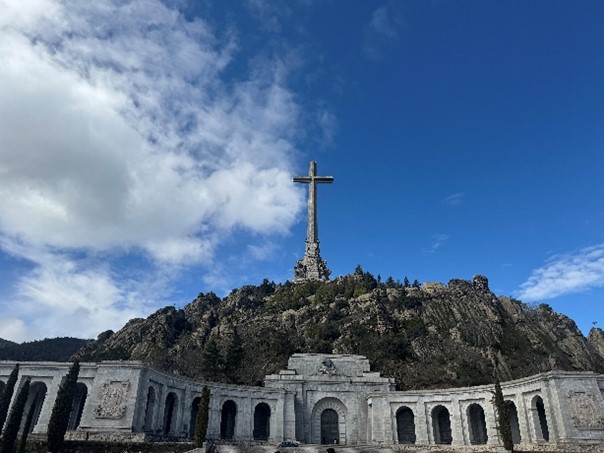Our last day in Madrid was spent in the Valley of the Fallen, recently renamed Cuelgamuros Valley, in Sierra de Guadarrama. The Valley is one of the most controversial places in Madrid. It was constructed between 1940 and 1959 and commissioned by the Spanish dictator Francisco Franco, who was the leader of the Nationalist forces during the Spanish Civil War, which to this day remains a forbidden topic to teach and discuss to this day thanks to the Pact of Forgetting, which was established in 1977, three years after Francisco Franco’s death, as Spain was transitioning into a democracy.

The Civil War in Madrid, Spain, lasted 3 years, from 1936 to 1939; the war resulted in a win for the right-wing Nationalists, which, as stated, was led by Franco. Francisco Franco’s dictatorship lasted 40 years, which ended with his death. The Nationalists consisted of monarchists, conservatives, fascists, and the military; these individuals were supported by the Catholic Church, Adolf Hitler from Germany, Benito Mussolini of Italy, and Antonio de Olivero Salazar of Portugal. The nationalists received arms, soldiers, and funding to continue and prevail during the war. The nationalists strongly opposed the left-wing Republicans, who were composed of socialists, communists, anarchists, and liberals; these individuals were supported by the Soviet Union, Mexico, and international brigades such as those from the US, UK, and France, who provided weapons, arms, advisors, and funding.

The Valley of the Fallen was created as a memorial for those who perished during the Spanish Civil War. Now, many see it as a symbol of the Francoist victory, so it is expected to see Franco supporters visit and do the Nazi salute as an homage/tribute to Franco, which is one of the most significant controversies the Valley faces today. Since many Spaniards view the Valley of the Fallen as a memorial to Franco’s dictatorship rather than reconciliation, many wish for its closure. The Basilica was carved into the mountain, which is astonishing. Political prisoners built the site under forced labor. What makes the Valley of the Fallen such a unique place is that the cross is 150 meters, around five hundred feet tall, making it one of the tallest in the world. Moreover, the Valley of the Fallen is home to the Underground Earth Tide Laboratory, a geophysical research facility, making it one of the deepest underground laboratories in the world, with a depth of 250 meters, around 820 feet below ground. The lab is used to study the earth’s crust deformations caused by the gravitational pull of the moon and sun. Afterward, the data collected is used for earthquake research, underground fluid movements, and even to predict geological changes. The lab was established during the 1950s while the monument was constructed.


Additionally, within the walls of the Valley, the bodies that are buried are of the soldiers who perished during the Civil War without the consent of their families. To make matters worse, these individuals’ bones are scattered and mixed, so no one knows which part belongs to whom or what side. There are 33,800 individuals buried within the walls of the Basilica; many believe this to be false, and the number is expected to be much higher. Furthermore, Franco was buried in the Valley, but in 2019, his remains were exhumed and reburied in his family cemetery, as what is in store for the Valley of the Fallen is expected to become a historical monument focusing on the victims rather than Franco’s followers.

The Valley of the Fallen is breathtaking, with fantastic scenery that brings peace to anyone who dares visit. The history and building of the monument are staggering. Stumping, everyone wondered how a place so lovely could have been constructed in such terrible circumstances. Considering that the monument was built inside the mountains, there were no excavations. It is 820 feet deep and has a cross that is five hundred feet tall. It is a mind-blowing experience that everyone must experience at least once in their lives. Unfortunately, we were not allowed to take pictures inside the church.






We hosted our farewell dinner in a restaurant called La Taberna de Peñalver Cava Baja, which makes the best paellas and seafood rice in Madrid, with a 4.8 out of 5 rating from its customers. The servers were excellent, with amazing appetizers, a spectacular variety of seafood, rice, and paellas, and home to the best dessert I have ever tasted. Overall, it was a fantastic experience that will be with me for the rest of my life; the ambiance, the people, the culture, and the food are unforgettable.


Adiós, Madrid. ¡Hasta luego!
